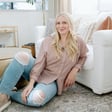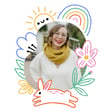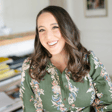Become a Creator today!Start creating today - Share your story with the world!
Start for free
00:00:00
00:00:01

Episode 196 - How to Write an Email Welcome Sequence that Sells
By using a targeted series of emails, businesses can turn new subscribers who are only vaguely familiar with the brand into loyal customers or clients. A well-crafted welcome sequence is a powerful tool in any marketer's arsenal, and can help to drive conversions, build relationships, and increase revenue.
As always, links and resources can be found in the show notes. Check ‘em out at https://daveyandkrista.com/how-to-write-an-email-welcome-sequence-that-sells/. And if you enjoyed this episode, please consider leaving a review over at Apple Podcasts.
Transcript
Introduction to Email Welcome Sequences
00:00:05
Speaker
Yep, so that's what we're jumping into today. Here's an outline that you can use for a five email welcome sequence that's designed to engage your subscribers, train them to take action, and educate them about the transformation that your business offers. Welcome to the Brands at Book Show, where we help creative service-based businesses build their brands and find more clients. I'm your host, Davy Jones.
00:00:30
Speaker
We are continuing our email marketing series and discussing email welcome sequences. That initial set of emails a subscriber receives that introduces the subscriber to your brand, educates them about the transformation you offer through your product or service, and hopefully
00:00:46
Speaker
moves them closer to purchasing or booking.
Email Marketing Resources and Challenges
00:00:49
Speaker
We have so many email marketing resources, including step-by-step tutorials. So no matter where you are in your email marketing journey, if you have a question, check out the show notes. We probably have a tutorial. And if we don't, send us a DM on a Scram and we'll point you in the right direction, or maybe we'll create a tutorial based on your question. Also, we are hosting a free
00:01:12
Speaker
five day email marketing challenge that will walk you through getting started with email marketing. You can sign up for that over at DavianChrissa.com forward slash email dash marketing. There's a link in the show notes and that will begin on June 5th. But even if you miss it, check out that page for more email marketing resources.
00:01:32
Speaker
As always, links and resources can be found in the show notes. Check them out at DavianCresto.com. And if you enjoyed this episode, please consider leaving a review over at Apple Podcasts. Now, on to the episode.
Humorous Aside: Pizza Preferences
00:01:50
Speaker
Yeah, so what pizza do you think we're getting yet?
00:01:52
Speaker
Oh, well, I already looked at the menu and definitely the hot honey because our favorite pizza place, which is in our town, it's called Heliotrope. They don't always have the same pizzas, but when they do have hot honey, that is my favorite, which hot honey is a new thing to me. Maybe it's like a Southern thing, but I had never heard of it before moving here. I'm excited. Yeah. What are you going to get? Do you know? No, I'm not sure yet. Something with meat. Something with lots of meat. Yeah. Yeah. But anyways, we're talking about how to create a welcome sequence that sells, not about pizza.
00:02:20
Speaker
All right, maybe your welcome sequence will include some of your favorite- Pizza, restaurants, I don't know. Yeah, yeah, who knows.
Importance of Welcome Sequences
00:02:26
Speaker
Anyways, we are talking about how to create a welcome sequence that sells. I think email marketing top of mind lately, one, because we're revisiting our funnels and we're revisiting our email sequences and in particular our welcome sequence. I've also lately been working on some outlines of welcome sequences or indoctrination sequences for some of our clients over at Till Agency. So this is just a topic that's been top of mind
00:02:50
Speaker
And I talk to a lot of people who have started email lists, but then they don't actually send any more emails or they don't send any emails. And I've seen people while working on websites who start their mailing list, maybe they have a lead magnet, but then nothing else after that.
00:03:06
Speaker
Yeah. And you know, I think that there's, you know, it's kind of like, okay, so I have this email list. I know the benefits of having an email list, but you know, kind of what do I do from there? You know, like what do I send? You know, what's the point of welcome sequence? Right. So we're going to talk a little bit about that in today's episode. We are not going to talk about different email marketing platforms, technical setup. We have other episodes that cover that content.
00:03:29
Speaker
and we have blog posts that cover that content. And even better, we have YouTube videos that cover that content. So if you're actually looking for how to, I don't know, connect your Flow Desk form, we have a YouTube video for that. All of those resources, as always, will be in the show notes. If you are trying to do something,
00:03:45
Speaker
and you're not quite sure how to do it and we don't have a YouTube video for it already, send us an email because we will, I mean, almost definitely create a YouTube video about how to do that, right? Well, we probably can't do that for every single email platform out there, but maybe...
00:04:01
Speaker
But point being is like, that's how we create new content is somebody, you know, we get questions on like, how do you embed your convert kit form? And, you know, we make a video about it. So send us an email if you can't find the tutorial that you're looking for.
Objectives of a Welcome Sequence
00:04:14
Speaker
Can't promise that we're going to make that video right away, but it will go on our list. And we can probably point you in the right direction in the meantime. So today's episode all about creating a welcome sequence that sells.
00:04:27
Speaker
Do you want to first explain what a welcome sequence is for anyone not familiar with that term? Yeah, welcome sequence is what it sounds like. It's a sequence of emails, all right, a series of emails that welcome somebody to your email list or your email community. It's also sometimes called an indoctrination sequence. I always thought that sounds a little culty, cultish.
00:04:51
Speaker
But point being is the idea is you're indoctrinating people with whatever it is that you do. You're getting people familiar with your business, how your business approaches a specific subject. And I think most importantly, these sorts of transformation that your business offers somebody as a result of using your service or your product. And so a welcome sequence does that and that's what we're covering. So what are some things that successful welcome sequences do?
00:05:20
Speaker
Yeah, I think that's a good place to start. You know, I think there's a few keys to welcome sequences. So if you've set up a welcome sequence, well, I think at the end of the day, it's going to capture somebody's attention.
Engagement Strategies for Subscribers
00:05:31
Speaker
And I want to emphasize that this is not just for one email. Anybody can capture somebody's attention momentarily, quickly, right? But you want to capture somebody's intention and engage them throughout the entire series of emails, okay?
00:05:48
Speaker
Can I stop you here and ask like how many in the series we're going to talk about? Yes. What we're talking about today, and I'll mention this even though we're going to get there, we're talking about a five email welcome sequence. So there's, you know, I don't think there's any special length to a welcome sequence. And we talk about that in a little bit, but we're talking about five email welcome sequence. And hopefully by the end of this episode, you know, very practical tips for getting this up and running.
00:06:14
Speaker
But going back to that initial point, you're capturing somebody's intention, you're trying to engage them through the entire welcome sequence. How you do this, primarily done by offering valuable, helpful, relevant content. So whenever you're in doubt when creating an email sequence, we're creating content in general. Offer your best content.
00:06:36
Speaker
And do you mean like in the actual email itself or can you link off to it? Is that? Yeah, you can link off to it. But the idea is that you are offering people stuff that's relevant to them and stuff that's helpful to them. That's how you keep people engaged. They know when they open your email, they're going to find something that's useful. OK.
00:06:55
Speaker
So that's number one. The second thing, it trains your subscribers. So what I mean is that you are training your subscriber to take an action in your email. This might be training your subscribers to click links in your email. Two other content, like you just mentioned. Two other content. It might be always including a PS in your email. And I think we have another episode where we talk about the importance of a PS.
00:07:25
Speaker
knowing when emails are coming. All right. And this goes back to being consistent when sending emails,
Email Frequency and Consistency
00:07:31
Speaker
right? If you send an email once a year and it's kind of random when you send emails, you're not doing a good job of training your, your subscribers as to when they can expect an email to come from you. Is there like an ideal frequency for welcome sequence sending?
00:07:45
Speaker
Yeah, and I think we should get to this when we talk about the welcome sequence. Right now, what I really want to focus on is training your subscribers. So what I mean there is that when you send emails, eventually you're gonna send emails to push people to, let's say a sales page or something like that.
00:08:01
Speaker
and you wanna be able to sell your product or service, but you're gonna need somebody to click from your email to that landing page. So if your emails never contain a link, if they never contain a call to action, you're not training your subscribers to then click a link to go to content.
Educating Subscribers on Problems and Solutions
00:08:19
Speaker
So another, something else in there is like you don't want necessarily to include 100 links in an email. First of all, it's not good for email deliverability. So if email service providers, they see there's a bunch of links in email, then it makes it maybe a little bit more likely that that email is gonna go to the promotions box or it's gonna go to spam or something like that. So you should really focus on, okay, what link do I want people to click on in this email? So highlight maybe a piece of content, highlight wherever it is that you want people to go.
00:08:47
Speaker
Do you feel like it needs to look like a button? Does that increase clicking?
00:08:51
Speaker
No, I don't think so. I think it definitely needs to look like a link though. So if you have a hyperlink and it's the same, it's not like a different color with the underline, things like that, then there's no way for somebody to know it's a link. So you want the links to be obvious for sure. I don't necessarily think that needs to be a button. There's a few email lists that I'm subscribed to that I open all the time and it's just a plain text email. There's no buttons or anything like that. But I know where the links are. That's a good question.
00:09:20
Speaker
And then number three, it needs to educate your subscriber or plant a seed. What I mean is that you start opening your subscribers minds to new possibilities. All right. So for instance, this might be mean making a subscriber problem aware. Okay. So for instance, somebody, you know, they get on your email list because they downloaded an ab workout. Okay. So your best ab workouts or whatever.
00:09:46
Speaker
but maybe what you really offer is a nutrition plan because you know that's really what makes the difference, right? And so you need to make people aware that they can't out train a bad diet, right? So if they actually wanna achieve that six pack that they're looking for, they're gonna also have to commit to a diet.
Traits of Successful Sequences and Common Mistakes
00:10:03
Speaker
And so, you know, if you offer a diet plan, then you're starting to seed that sale, right? And you're starting to make them aware of the problem. Like, Hey, have you tried working out thousands and thousands of hours and seeing no progress? You know, maybe it's because you're missing this, right? In a similar way, you might be convincing a subscriber that results are possible for them too. You know, so this might be, you know, like, can we think of a website example?
00:10:29
Speaker
Oh, for a website? Yeah. People might think that it's just not possible for them to book or to increase their traffic. Yeah, maybe they've just experienced so much frustration for so long around, you know, having a website that it feels like, oh man, they're just not getting traffic to their website. They feel like it's beautifully designed, they have the right images, they have the right copy, you know? But maybe it's a matter of saying, okay, well, you know what, you know what you're missing? And you know what's made the difference for so many other people is a content strategy.
00:10:57
Speaker
And having a content strategy in place, now this is the missing piece for getting consistent traffic to your website or an email list or something like that. So those are the, I think the three things that a successful email welcome sequence does. It captures somebody's intention and engages them. It trains the subscriber and it educates the subscriber as well.
00:11:17
Speaker
Are there some things that people should avoid doing? Yes, for sure. The first mistake I think I see in emails is that people try to do too much, okay? So, you know, this is, I think, a typical mistake of somebody who, like us, has maybe a lot of different products and services, right? And you're trying to sell all your products and services all at once, right? You don't wanna do that. You wanna stay focused on what I would call your core transformation that you offer people.
00:11:46
Speaker
And if you can stay focused on your core transformation, your core offer, then those secondary offers and secondary transformations start to fall into place. Okay. All right. Being too salesy. Honestly, I hesitate to say that one because I think a lot of people when they're first starting an email list are already worried about being too salesy and they're actually not salesy enough. So I think you can err on both ends of the spectrum.
00:12:09
Speaker
Would this be like not giving them any content and just like hitting them with offers right away? Is that what you mean by two salesy? Being two salesy would be like being your stereotypical used car salesman, you know, where it's all you make it all about you and you make it all about, you know, somebody getting out their wallet and buying, right?
00:12:28
Speaker
So that would be being too salesy. You know, not being salesy enough is like just not really, you know, at the end of the day, if somebody's like, yeah, you know, maybe even the emails are helpful, but they're like, I'm not even really sure what, what is the big idea here? Like what is the thing that this business offers? You know, if people can't answer that question at the end of the day, then, you know, you're not doing a good job of making it clear what it is that you do and what it is that you offer people.
00:12:51
Speaker
I think worrying about giving too much away, like in terms of content, that's another pitfall. And I would say give your best content away. When people reach out to us about SEO over at Till Agency and ads for that matter too, we tell them at the outset exactly what it is that we will do for them. I mean, of course, like as they get onboarded and as we dive deeper into their business goals and things like that, we'll refine the strategy, of course.
00:13:19
Speaker
But at the outset, based on what we know, we say, hey, yeah, this is what we think the strategy should be. And yeah, there's always a possibility that they take that information and they go like iterate on that themselves, right? But most of the time they want your expertise and they want the done for you aspect. And I think that people are like that in most situations. Yeah, 100%. There's things that we outsource all the time that we're capable of doing.
00:13:43
Speaker
Yeah, I mean, I think of that with websites. You could buy one of our templates and customize it yourself. So many people do that. We have really detailed videos where we explain how to do it, but a lot of people just don't have the time or they want it outsourced. And we outsource things all the time. Yeah, exactly. And things that we're very capable of doing ourselves. So I think that when you give your best content away, you establish yourself as an authority and you establish yourself as somebody that can be trusted. And it just makes it much more likely that people are going to want to work with you.
Post-Welcome Sequence Engagement
00:14:10
Speaker
And I think the biggest thing
00:14:13
Speaker
This is the biggest issue and it's not necessarily with welcome sequences, but what happens after the welcome sequence is people, maybe they create the welcome sequence, but then they never send an email after that. And there's these people that just hang out on this list and never get an email or they get an email so sporadically that when you do send an email, that, you know, it just lands in spam or it's just like not even relevant for that person anymore. And I want to emphasize the importance of sending consistent emails, not only because it builds trust, right?
00:14:41
Speaker
You know, like when somebody's just randomly reaching out to you, that doesn't build trust.
00:14:46
Speaker
Right. Cause you're like, who is this person? Yeah. The people that you trust the most are the people who are consistent, right? I mean, they're the people who you hear a consistent message from show up consistently. So it's important just on that level, but for email service providers, you know, like Gmail, for instance, when you're only sending emails once in a while, it makes it much more likely that that email service provider is going to flag that email as spam or junk or a promotion. It's not going to end in their inbox.
00:15:14
Speaker
You may not have an answer for this, but is there a sweet spot for how often to send emails? I wouldn't say that there's a magic number per se, but I would say that you want to be sending emails at least once a week. That's not necessarily the cadence in which you want to send your welcome sequence. We'll talk about that again in a minute. But on a weekly basis, somebody on your list should be receiving at least one email from
Structure of a Five-Email Welcome Sequence
00:15:36
Speaker
you.
00:15:36
Speaker
Okay. Yeah. So do you have like a basic formula and outline for what to actually include in this welcome sequence? Yes. So I have a simple outline here of a five email welcome or indoctrination sequence. Okay. What I want to emphasize here, especially for people who have never done this before is when in doubt, keep it simple.
00:15:58
Speaker
and use your best content. Okay. All right. So, you know, don't get tied up on, especially when you're in your email platform and you're like, you click the integrations tab, you know, and you're like, Oh wow, all these different things I can do with emails, right? Don't get distracted. If you've never done this before, just get something up and running and you can always iterate on it as you go. Okay. So keep it simple.
00:16:22
Speaker
I will include a few tips for kind of leveling up your email, your welcome sequence as you go. But in general, this is just a solid five email framework that you can use that will hopefully achieve the three things that we talked about achieving in the beginning, capturing people's intention and engaging them.
00:16:39
Speaker
earning your way in their inbox, training your subscribers to take the action that you want them to take, and educating your subscribers as well, making them more likely that their mind is open to what it is that you offer. So again, hopefully the goal here is creating an email welcome sequence that sells.
Email 1: Delivering Lead Magnet Content
00:16:57
Speaker
All right, so we should start with email number one, right? Yes. So what is an email number one? All right, so email number one, you are delivering content. What I mean is that you have probably got somebody to get on your email list through offering some sort of lead magnet.
00:17:14
Speaker
you want to deliver that lead magnet. Simple enough, right? So email one is about delivering that content. Now, here's the key. When you deliver that content, you want to make sure to remind people why they should download, why they should open, why they should view that content, depending on what kind of lead magnet that is, right?
00:17:34
Speaker
Oh, I do have a question. So you have talked about doing mini courses for emails. If you were delivering a mini course and that was like a five day mini course, would you then after that send them into the welcome sequence or would each day of the welcome sequence also be the five like mini course days?
00:17:52
Speaker
Yeah, that's a great question. So you can do this one of a few different ways. My recommendation would to have some confirmation email that, you know, lets people know that they've subscribed successfully, that reminding them, you know, why they're there. And that's the key to like in that first email, you want to remind people why they're on your list. You're on this list because you downloaded, you know, XYZ or you signed up for XYZ.
00:18:16
Speaker
And remind them why that's important. You know, remind them of that transformation or benefit that you're offering them. You know, if they're downloading SEO guide, remind them why it's important for them to actually put that SEO guide to use. Remind them why the five day challenge that you're about to enroll them in is important. But I would say the five day challenge starts next. OK, so you might pause the welcome sequence.
00:18:39
Speaker
So you have that initial email that reminds them of all those things. They go into the five day challenge and then afterwards go into some additional indoctrination sequence for most other cases. So if you're not doing a five day challenge or you're not doing any email mini course. If you just have like a PDF that they're downloading. Yeah, you're just going to go like you're not going to go down that.
00:18:59
Speaker
Okay, cool. That is a good question. If you've listened to the last episode, we talked about different kinds of lead magnets. One of the lead magnet ideas that we talked about was a five day challenge or email mini course. Do you think that this first email should include an offer?
00:19:13
Speaker
Yeah, so I mean, that's a good question too. So I would say that, you know, if you have some sort of offer to make people that including that offer on the thank you page when they initially subscribe to your email list and in the first email is sort of key. And one of the reasons that it's key is because 100% of people who subscribe are gonna see the thank you page, right? Not everybody's gonna actually see the email because the truth is there is a percentage of people who will subscribe to an email list and then not actually open the email.
00:19:43
Speaker
There's a percentage of people who will subscribe to an email list and that email will go to spam for whatever reason, and they'll never see it. There is this percentage of people who put in their email and it's the wrong email. All frustrating things, but 100% of people are going to land on the thank you page.
00:19:59
Speaker
So if you have something to say that's important, say it there. That might be an offer. That's probably directions for what somebody should expect. Hey, go check your inbox right now. And if you don't see it, check spam. And if you still don't see it, send us an email at wherever, right? So all of that kind of stuff is important. But like getting back to email number one, I think just, you know, if you've never done this before again, deliver the content and make sure to remind people why they should
00:20:26
Speaker
take action with that content. And remember, if they don't take action, that's not a good thing. Yeah, they're on your email list, but you want them to take action because you want them to experience that quick win that we talked about in our previous episode.
Email 2: Introducing the Sender
00:20:42
Speaker
You want them to experience that little transformation so that they know, oh wow,
00:20:46
Speaker
I mean, this is just from a download. What kind of transformation will I experience if I follow this person more? So I think sort of the next level from there is extending the content. You might deliver that download and then also deliver maybe some sort of bonus video that explains how to make the most of that download. All of that kind of stuff can be done in email number one.
00:21:07
Speaker
I think that in one of our welcome sequences where it's like they're getting access to a brand guide, we link off to other brand videos that might be relevant. Exactly. Yeah. And it's just a simple way to extend the content that somebody's receiving. And maybe they don't open the initial download, but they watch some of those videos and get a lot out of that.
00:21:26
Speaker
But email number one, just as a recap, deliver whatever content that you promise to deliver people, remind them of why it's important. In other words, explain the benefit of them actually putting that information to practice and then maybe extend the content or make an offer. If you make an offer, one of the reasons that you would do that is because of your email sequence, of your welcome sequence, the highest open and click rate is typically going to be in that first email, which is why you might want to include offer in that first email.
00:21:56
Speaker
That might not be applicable to everybody though. And don't let that be the reason you don't get a welcome sequence up. Like don't not get a welcome sequence going because you're like, ah, I'm just not sure what offer to make yet, right? Yeah. Do you feel like if someone's a service provider couldn't offer the inquiring or contacting them, or do you think it's more like appropriate for a sale?
00:22:15
Speaker
Yeah, I wouldn't call that the strongest offer. I would say the offers that I have in mind probably lend themselves to course creators and people with digital or physical products maybe a little bit more easily than to a service provider. It depends on what kind of service provider you are. But it could be like in the PS, maybe you're like, hey, maybe you are a brand photographer and somebody's downloading a shot list of the things that they should keep in mind for their next
00:22:40
Speaker
brand session to make the most out of it. And maybe the PS is like, hey, if you're ready to book professional brand photos, reach out to us. And you keep it simple like that.
Email 3: Core Offer Content
00:22:53
Speaker
All right, email number two, I call that the actual welcome email, right? So you are maybe taking a little bit more time to introduce yourself, but here's the key of that email. You wanna introduce yourself in the same way that you would introduce yourself on your about page, all right? At least the way that we think you should introduce yourself on your about page. And how should people do that? This is a common error we see.
00:23:13
Speaker
Yeah, don't make it about you. All right. You want to make it about your ideal customer or client. You want to establish yourself as the guide. All right. So anything you're doing to introduce yourself and tell people about yourself, you're doing it sort of in the context of establishing how you can help somebody and what it is that your business does to get people results.
00:23:36
Speaker
I've seen a portrait photographer do this very well by explaining the horrible experience that she had when her daughter was a newborn and the photos that she just didn't feel good about. And then she relays that to her ideal clients and how she doesn't want them to have that experience. And she shows herself as a guide in that situation.
00:23:55
Speaker
Yeah, exactly. And so she's able to share a little bit about herself without making it about her. Right. So you want to introduce yourself taken about page approach, that'd be our advice there. We have content about about pages that will link to in the show notes. So if you want to know a little bit more about how you can do that, check out those resources. It's a great place to start incorporating social proof, but again, in a way that doesn't make it about you.
00:24:21
Speaker
Do you have an example for that? Yeah, yeah, yeah, yeah. So I mean, going back to, I don't know, maybe like speaking about the transformation that you can offer people, and I'm thinking maybe a photographer or whatnot, you know, it's like a humble brag, you know, you could slide in that you've been featured in Martha Stewart, you know, weddings or whatever, right? Anyway, that's not just a list of, hey, I'm the best, here are all the places that I've been featured, right?
00:24:46
Speaker
So it might be like introducing maybe your thing is that you want to capture those special intimate moments of people's families during a wedding, right? Maybe that's kind of your thing. Like you capture those candid moments. Okay. And so you talk about how, you know, like,
Email 4: Social Proof Through Storytelling
00:25:04
Speaker
I don't know, maybe you're telling a story of somebody else or maybe you're telling a story from your own wedding. There's a million different ways you could tell the story, I guess. But then you say, check out this photo of this mom and this grandmother, and it was the last photo they took together. And this photo actually ended up being featured in XYZ. Obviously, that would require a little bit of finessing. But point being is that you're sharing that without, again, really making it about you.
00:25:30
Speaker
Do you think including like a testimonial blurb would work, that if you worked into the text like smoothly, or do you think that's not a good spot? Yeah, that's a little bit harder. I'm not saying it's bad, you know? Well, I guess if you're talking about like the mom and the grandma, you could say like, from this person, this photo meant so much to me, like we displayed it in my grandmother's.
00:25:49
Speaker
Yeah, you can do that. And I mean, there's definitely ways to do it. I'm thinking about like, if you're a mindset coach, and you're talking about the actual mindset transformations that you offer people, and maybe you're telling the story of a few different types of people who never thought whatever transformation was possible for them. And again, you're sharing about what it is that you do and offer, but you're making it about others, right?
00:26:15
Speaker
Yeah, I would say that you want to give people somewhere to go. Okay, so once you wrap that up, you want to tell people to go take a specific action. I think this ties back to training your subscribers, right? So you should always have a strong call to action at the end of your email or within your email, right? So, you know, this might be as simple as, hey,
00:26:34
Speaker
wherever it is that you show up on social media. We have a lot of different social media accounts. We're on Pinterest. We're on YouTube. We're on TikTok. We prefer connecting with people over at Instagram, you know, over on Instagram. So like it might be like, hey, come follow us over on Instagram. This is where we share some of our best content. We always answer every DM.
00:26:54
Speaker
I mean, I guessing it could also be over to more content, right? Yeah, it could definitely be over to more content as well. So I like making sure that you're sending people somewhere else to connect with you because I think if they're consistently connecting with you on multiple platforms, it's a way to sort of build trust in a subtle way, right? So now they're following you over on Instagram and they're seeing your posts over there. At the same time, they're receiving emails from you. Maybe it makes it more likely that they go over to your website and read your blog.
00:27:24
Speaker
Do you think there's an ideal length that these emails should be? Yeah, I would say it depends on the person. You know, if you don't feel like you're a strong writer and really where you best connect with people is like over on Instagram via reels and DMS and things like that, then keeping the email short and sweet and getting people over to Instagram where you feel like you can more authentically connect with them, that's fine. So your emails might be a hundred, 150 words, right?
00:27:49
Speaker
For somebody who maybe likes a little bit of writing, I like writing. I like connecting with people literally through letters. My emails might be 600 words long. I think it just depends on your brand. I wouldn't try to force something that you don't feel like is all that authentic for you. Is there a length that's too long, do you think?
00:28:10
Speaker
Yeah, I mean, I would say once you get over 600 words, then you should be linking off maybe to a blog post or some sort of piece of content that's better suited to long form content. All right, email number three. I think that this in general should be a content
00:28:28
Speaker
Focused email. All right. You want to be offering maybe bonus content, but it should be like your best content. And this content, again, should be related to what it is that you do. Again, thinking about your core offer, that core transformation you offer people, what it is that you want people to purchase. It should be related to that in some way.
00:28:45
Speaker
Should it be related to the initial thing that they downloaded or got to get on the list? It doesn't have to be. I mean, obviously the two should be related in the sense that it's all coming from the same business, right? But it doesn't have to be like directly related. Okay.
00:29:00
Speaker
So this bonus content, maybe you're offering your end product, what you want people to ultimately buy is a membership, right? Maybe you could take a video from that membership and put it in an email and don't make it like, oh, this is a preview of the membership. Don't contextualize it as if it's like, oh, just a teaser or just a preview for this thing that you can buy.
00:29:22
Speaker
but really focus on like that piece of content and how it can help somebody and definitely mention that, hey, this is actually content that all our members get to experience and they get to experience a lot more of it, but you don't want to make it sound like this is like nothing.
Email 5: Reiteration and Future Engagement
00:29:38
Speaker
Like it should be good standalone content that you're offering and it should be some of your best content as well. Do you think that it would be a mistake to actually make an offer in this email or do you think it's better to just see to sale?
00:29:50
Speaker
Yeah, I mean, it depends. You know, I would say in the PS for sure, it's appropriate to say like, Hey, if you like this and you know, this is for you. And again, the language here needs some finessing. I think definitely reiterating the offer that you already made in the welcome email and telling people like, Hey, you know, this offer is going to expire in the next few days and reminding them of that is totally appropriate. Okay. Yep. Email number four.
00:30:14
Speaker
Stealth social proof email. Yes, stealth social proof email. So this email and email number two, I think share a lot in common in this way. The idea is that you want to establish yourself as an authority, all right? You want to establish yourself as somebody who truly has offered people, like real people, the transformation that you say you can provide people, okay? You also don't want to do this by just listing 10 testimonials.
00:30:42
Speaker
hey, I'm legit, read these 10 testimonials. That's not what you want to do. A better way to do it is to tell a story. So make it a content focused email with a story overlaid. Now, what I mean here is, so maybe the subject line of the email is this, this simple trick changed everything for this business owner. And maybe it's, I don't know, pick an industry.
00:31:10
Speaker
Do you want me to do SEO or do you want to do fitness or? Yeah, I always do fitness and SEO. Uh, cooking. Okay. Cooking. I don't know. This simple trick or knowing, knowing when to use a simple ingredient transformed this dish or whatever made this dish the favorite of friends and family. I don't know. Maybe they're selling a cookbook.
00:31:31
Speaker
Yeah, exactly. I don't know. And maybe there's like a certain theme to how you know when you use certain ingredients or whatever. But you can talk about maybe somebody who has bought your content, whatever it might be, your course, your cookbook, whatever, they learn this principle. And when they learn this principle, all of a sudden, everybody wanted to be a part of these monthly dinner parties that they host, right?
00:31:55
Speaker
And so the key here, and this is why I call it the stealth social proof email, is it's really about the content in that email and less about the specific person, but you're using a specific example. So it's less about Krista and Krista saying that there's no point in that email where you're hearing from Krista that she experienced this transformation or whatever. You're hearing a story about Krista and how it transformed her life.
00:32:25
Speaker
And like, would it be appropriate to link to the product that was used? Yeah, you could link to the product that was used for sure. Again, if you're offering, if you have a certain offer that's running in the background of this Welcome to Sequence, then you should be calling to mind that offer in every single email. Okay, I wasn't sure if there's like too many times you said not to oversell.
00:32:44
Speaker
Yeah, so what I mean by oversell is not, oh, like don't put your offer in front of people too much. What I mean by oversell is don't be sleazy. So basically what you want to do is you want to be able to tell a story of somebody who experienced your transformation, make it so that when somebody closes that email, they remember, you know, like a piece of content there. Oh, that was really interesting about the salt and pepper they used in that, you know, whatever that really, yeah.
00:33:12
Speaker
That special ingredient, I just put salt on everything. You do? I don't know. That was a terrible industry example for you to choose from. You could say it was like a special salt. Yeah, special pink Himalayan sea salt. That's why he's thinking of that.
00:33:27
Speaker
on that stake, you know? But you did a pretty good job coming up with the story. Yeah, but point being is that somebody walks away and they remember, oh, I'm going to try that next time, you know? But they also heard about somebody who experienced, you know, like they know that you're legit, right? Or starting to understand that you're legit and you help real people.
00:33:44
Speaker
Okay. So what about our final email? Yes, our final email. It's the offer email. So it's a final opportunity to take advantage of the email offer. So if you, you know, I would say like, email number five, if you are creating a welcome sequence, you don't have an offer running through your welcome sequence, then it could be optional. Okay.
00:34:03
Speaker
I would say maybe it's not even optional. Maybe you send an email, but it's just to tell people like, hey, this is what you can expect going forward. Like I've sent you an email every couple of days, but now you're going to get an email once a week for me. And it's always going to contain my best content, right? So you're giving people an idea of what comes next. Now, if you've made an offer in the first email and it's a time sensitive offer and it's unique to your welcome sequence, then this email should be like the final last chance email.
00:34:30
Speaker
And on this day, you might actually send up to three emails just saying, last chance, this offer goes away after this. And it depends on, again, the offer and what it is that you do and whatnot. But point being is that you want to make sure that you emphasize that it's the last chance to take advantage of the special offer.
00:34:47
Speaker
But then you also want to give people an idea of what comes next. You know, like what should they expect from you on a weekly or biweekly basis or however often that you're sending emails. I'm on email lists where I receive an email every day, you know, and I open it almost every day. It's a shorter one, right? I'm guessing.
00:35:03
Speaker
It is, yeah, it is a shorter email, but it's an email that I get every single day. And so, you know, I think people worry about like, oh, am I gonna get too much email? You know, people are all going to unsubscribe at some point, right? Like when you were getting ready to have Jack, our first kid, we were on so many different new parent email lists, you know?
00:35:25
Speaker
But once you have the kid, some stuff isn't relevant anymore, like what to expect. And every time that we send an email, we see people unsubscribe. Yeah, and that's true of every business I've ever worked with. If you were getting zero unsubscribes, let me know.
00:35:42
Speaker
And it's more likely that you're gonna get less unsubscribes with a smaller email list, but you're still probably going to get unsubscribes every single email you send. That is totally okay. Remember, you are paying for each of your subscribers, right? Typically an email marketing platform, except Flowdesk, this is not true of Flowdesk, but is going to charge you based on how big your email list is. So you don't wanna be paying for people who are no longer in the season of life that they need your product or service.
00:36:08
Speaker
Right. So unsubscribes are OK. And I would say they're better than the people who stay subscribed to your email list and just never open it anymore. Right. You mentioned sending an email every few days. Do you think that's a good frequency for this welcome sequence?
00:36:24
Speaker
Yeah, that's a great question. Maybe I should have answered this earlier. I would say for the welcome sequence that it's okay to send five emails in five days or maybe you don't send emails on the weekend. You can set that up in your email marketing platform. Some emails you'll send multiple in a day. If you have some sort of special offer and it's a last chance, you might send three last chance emails on
Conclusion and Listener Feedback
00:36:44
Speaker
the same day.
00:36:44
Speaker
So I don't think the cadence matters too much. I would say like, you know, for a five email welcome sequence, you probably want that to wrap up within two weeks at most. Okay. So that means that you're sending an email at least every two days. And if people are getting these welcome sequence emails, they also probably are not getting your other emails yet, right? Do you normally set that to be a setting?
00:37:09
Speaker
Yes, that's right. So people who are in our email welcome sequence are not getting our weekly emails. Okay. And that's all you can set up all that in your email marketing platform. That way people just aren't getting too many emails at once or they don't receive this like random email in the middle of their. Before they're familiar with you. Exactly. Yeah. Any other questions?
00:37:30
Speaker
I don't think so. One thing that I just want to emphasize is that after people go through your welcome sequence, make sure you keep sending them emails. You just want to make sure that you keep people engaged. Anyways, more email marketing podcasts to come.
00:37:46
Speaker
Okay. So if you're interested in this topic, we didn't answer the question that you were hoping we would answer, then send us an email, send us a DM on Instagram, and we'll consider making an episode or writing a blog post on that topic, or maybe pointing you in the right direction. But your questions make for the best episodes. Yes. That's so true. Yeah. Send them over. All right. Thanks for joining us, guys.
00:38:14
Speaker
Thanks for tuning into the Brands That Book Show. If you enjoyed this episode, please consider subscribing and leaving a review in iTunes. For show notes and other resources, head on over to davianchrista.com.
















